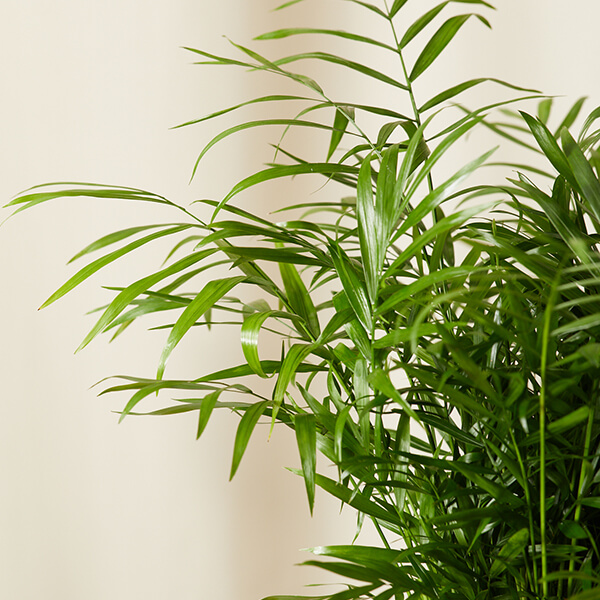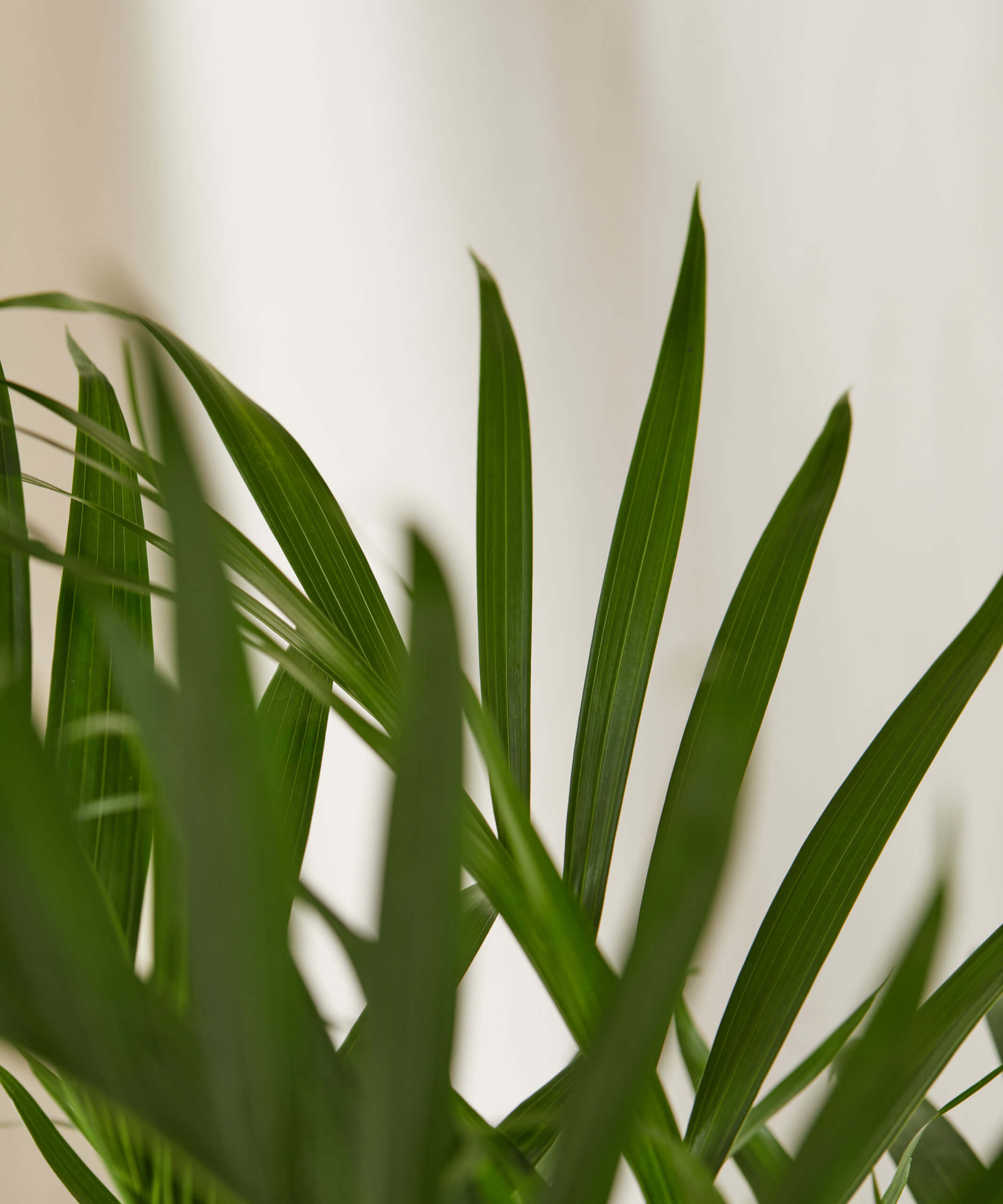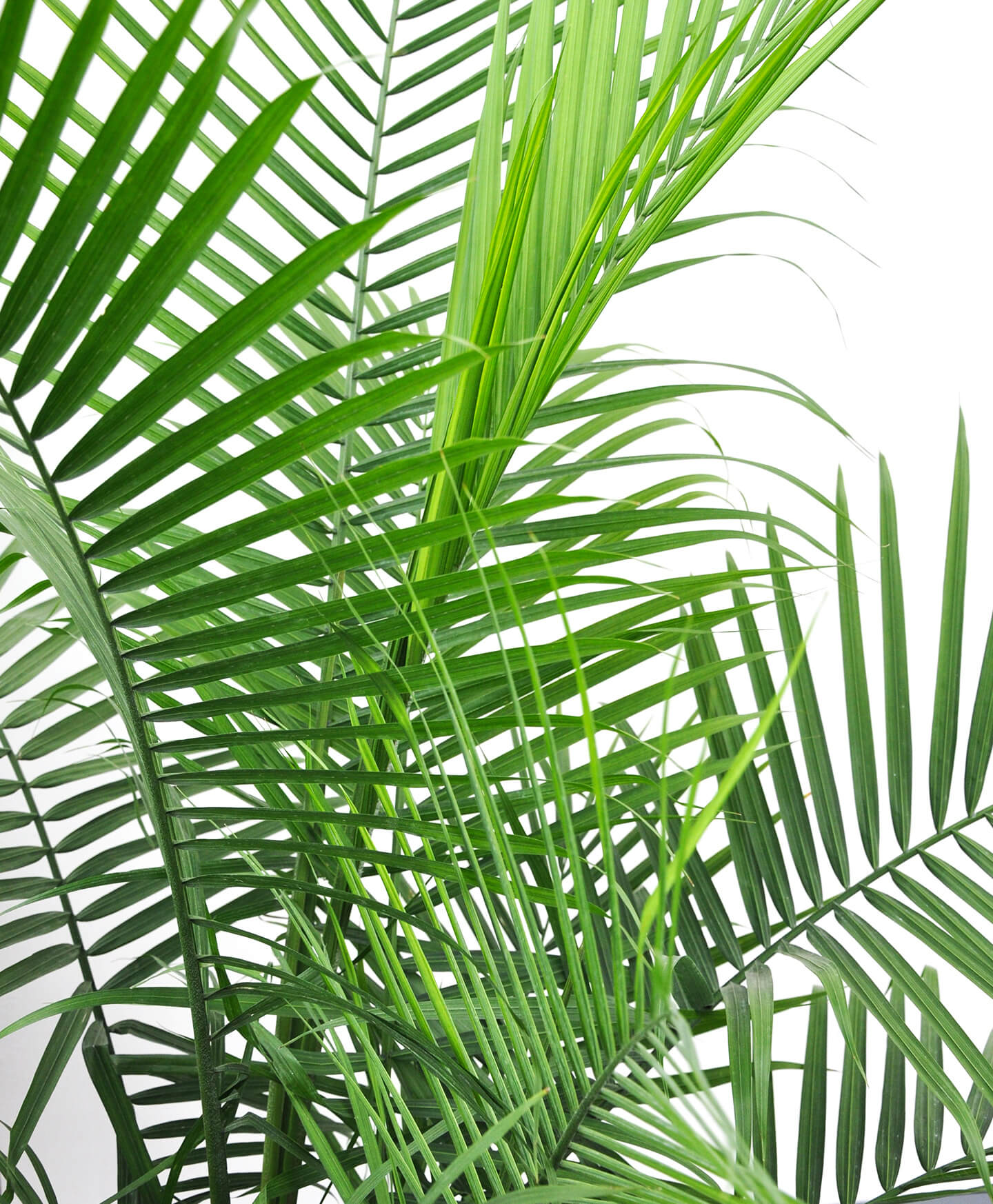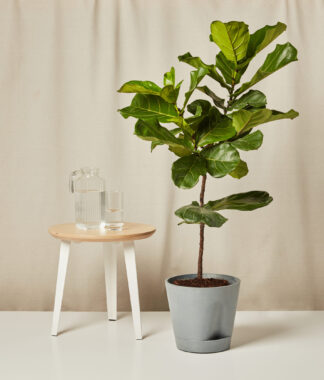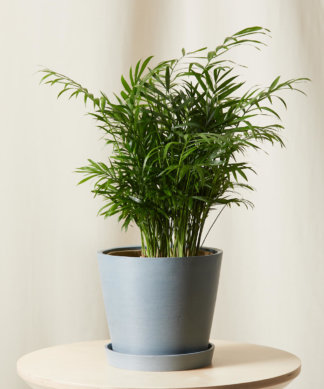How to care for your Palm
Use these instructions to care for a Palm. This guide will tell you how to water a Palm; its light, temperature, humidity preferences and any additional care it might need to help it grow.
Areca Palm
Your Areca Palm will appreciate bright indirect light as they can burn in too much sun. An east-facing window would be great for this palm. Areca Palms will not tolerate lower light environments well.
Water your Palm when the soil is about 50% dry. Palms do not like to sit in water, as this can lead to root rot. They can handle drying out occasionally, so don’t worry if you forget to water them once in a while.
Your Areca Palm appreciates added humidity. Make your Palm happy by misting them a couple of times a week, or adding a humidifier nearby. If the humidity drops too low, particularly during winter, fronds can start to crisp and die.
Your Areca Palm does well in normal room temperatures between 60–80 degrees. They will not tolerate temperatures below 55 degrees, as colder temperatures may lead to leaf damage.
Feed your Areca Palm once a month during spring and summer with a palm-specific houseplant fertilizer. Only apply fertilizer to damp soil, so that you don’t burn the roots.
Your Areca palm is considered to be non-toxic.
You can prune your Areca Palm to maintain a certain size or shape. Pruning also encourages more branching, which will make your Palm look more full. The best time to prune is springtime when their growth naturally increases.
Bamboo Palm
Your Bamboo Palm prefers bright indirect light. Keep out of direct sunlight as it may scorch the fronds. This palm does not do well in low light.
Water your Bamboo Palm when the soil volume is 50-75% dry. Water the plant until you see water flow freely into the saucer, making sure to discard the excess water. The roots may rot if they are exposed to standing water or extremely damp soil for too long.
Your Bamboo Palm will thrive in average household humidity. However, it will appreciate added humidity by using a pebble tray or placing a humidifier nearby.
Your palm prefers room temperatures between 65-85°F.
Fertilize your Palm once a month during spring and summer with a general houseplant fertilizer diluted to half the recommended strength.
Your Palm is non-toxic to humans and pets.
Look out for a common problem called ‘tipping’ when the tips of the leaves dry out and turn brown. The most common cause is tap water, which contains salts, chlorine, fluoride, and other elements that may be harmful in excess. To prevent this, you can use distilled water or rainwater. You can flush the soil a few times a year if you start to notice salt buildup in the form of a white crust-like cover on the top of the soil. Do this by removing that top later of soil and slowly but generously watering your Palm with about four times your pot’s volume of water. Allow water to completely drain from the pot and empty the saucer of any excess water before placing your Palm back in its place.
Cat Palm
Your Cat Palm prefers bright indirect light. It will grow faster in bright indirect light but it is not considered a fast-growing palm. Keep out of direct sunlight as it may scorch the fronds. This palm does not do well in low light.
Water your Cat Palm when the top 50% of the soil is dry. Water until you see water flow freely into the saucer. Always make sure the saucer is free of any standing water.
Your Cat Palm will thrive in average humidity, but will appreciate added humidity through misting or using a humidifier or pebble tray.
Your Cat Palm prefers average room temperatures between 65–80 degrees. Protect your Palm from cold drafts from windows, air conditioning vents, and doors.
Fertilize your Cat Palm once a month during spring and summer with a general houseplant fertilizer diluted to half the recommended strength.
Your Cat Palm is non-toxic and pet-friendly.
Water your Cat Palm using room temperature filtered water to avoid high salt content in the soil, which may cause brown edges on the fronds of your Palm.
Chinese Fan Palm
Your Chinese Fan Palm will do best with bright indirect light. Getting too much direct sunlight can burn the leaves. It will not do well in low-light areas.
Water your Chinese Fan Palm when the top 50%-75% of the soil is dry. Never let them sit in water or soggy soil, as this will cause root rot.
Your Chinese Fan Palm will thrive in average household humidity, but will appreciate any added humidity you can give it. Make your palm happy by misting it a few times a week, placing a humidifier nearby, or using a pebble tray to boost moisture.
Your Chinese Fan Palm will do best in normal room temperatures between 65-85 degrees. Avoid cold drafts and direct airflow from heating vents.
Feed your Chinese Fan Palm every month during spring and summer with a general houseplant fertilizer diluted to half the recommended strength.
Your Chinese Fan Palm is non-toxic and pet-friendly.
Your Chinese Fan Palm tends to grow towards the light. If you want to keep your palm looking its best, rotate it every month so that it will stay full and lush. Your Chinese Fan Palm has sharp barbs on the stems of its fronds. Use care when unboxing, moving, or repotting.
Coconut Palm
The Coconut Palm will do best next to a window where it can receive direct sunlight for at least 6-8 hours per day. It will not tolerate low light. It loves full sun outdoors, but will have to be acclimated first.
Water your Coconut Palm when the top 75% of soil is dry. Water thoroughly until liquid flows through the drainage hole in the bottom of the pot. Always empty excess water from the saucer. You Coconut Palm will require more water during the summer.
Your Coconut Palm will appreciate added humidity from misting, a pebble tray, or a humidifier.
Protect your Palm from cold drafts from windows, air conditioning vents, or doors. This plant prefers warm temperatures between 70-90 degrees. This plant may go dormant in temperatures below 55-60 degrees.
Feed once a month during the spring and summer with a liquid fertilizer for indoor plants.
Your Coconut Palm is non-toxic to humans and pets.
Your Coconut Palm leaves are sensitive to injury and may get brown tips. Cutting back the tips of the leaves is a good way to preserve the appearance of the plant. The key is to use sharp scissors to cut off just the discolored parts.
Date Palm
Your Palm prefers bright indirect light. Too much direct light can scorch the fronds.
Water your Date Palm when the top 50% of the soil is dry. Feel free to stick your finger down into the soil to feel for moisture. Water the plant until you see water flow freely into the saucer. Always make sure the saucer is free of any standing water.
Your Date Palm will thrive in average humidity. However, it will appreciate added humidity through misting or using a humidifier or pebble tray.
Protect your Palm from cold drafts from windows, air conditioning vents, or doors. This plant can tolerate a low of 50 degrees but prefers normal room temperatures between 65-80 degrees.
Fertilize once a month during spring and summer with a general houseplant fertilizer diluted to half the recommended strength.
Your Palm is non-toxic to humans and pets.
It is best to water using room temperature filtered water to avoid high salt content in the soil of your Date Palm, which may cause brown edges on the fronds.
Fishtail Palm
Your Fishtail Palm will appreciate as much light as you can give it. This palm will enjoy the bright sunlight that comes from a south or west-facing window. They will not tolerate lower light situations well.
Water your Palm when the soil is about 50% dry. Palms do not like to sit in water, as this can lead to root rot. They can handle drying out occasionally, so don’t worry if you forget to water them once in a while.
Your Fishtail Palm appreciates added humidity. Make your Palm happy by misting them a couple of times a week, or adding a humidifier nearby. If the humidity drops too low, particularly during winter, leaves can start to crisp and die.
Your Fishtail Palm does well in normal room temperatures between 60–80 degrees. They will not tolerate temperatures below 55 degrees, as colder temperatures may lead to leaf damage.
Feed your Fishtail Palm once a month during spring and summer with a palm-specific houseplant fertilizer. Only apply fertilizer to damp soil, so that you don’t burn the roots.
These palms are not toxic; however, their fruit is toxic. It is unlikely that they will produce fruit when grown indoors. If your Fishtail Palm ever produces fruit, be sure to keep it away from children and pets.
You can prune your Fishtail Palm to maintain a certain size or shape. Pruning also encourages more branching, which will make your Palm look more full. The best time to prune is springtime when their growth naturally increases.
Majesty Palm
Majesty Palms can adapt to low light levels but will be happiest in spot with bright indirect light. Avoid extended exposure to direct sunlight, as it may scorch the leaves.
Water your Palm when the top 50% of the soil is dry. Water until liquid flows through the drainage hole at the bottom of the pot and discard any water that has accumulated in the saucer.
Majesty Palms do best in high humidity, but can grow well in basic household humidity. If you wish to provide your palm with additional moisture, mist the fronds weekly.
Protect your palm from cold drafts from windows, air conditioning vents, or doors. This plant can tolerate a low of 40 degrees, but prefers normal room temperatures between 65-80 degrees.
Feed once a month during the spring and summer with a liquid fertilizer for indoor plants.
Completely non-toxic to humans and pets.
Quickly remove any fronds that turn brown or yellow. Doing so improves the look of your plant and allows a clean space and more energy for new leaf growth. The brown fronds do not necessarily indicate a problem if it is being watered properly. Like other palm trees, the fronds on your Majesty Palm will eventually turn brown and die.
Parlor Palm
Your Palm prefers bright indirect light but can adapt to medium to low light areas.
Water your Palm when the top 50% of the soil is dry. Water until liquid flows through the drainage hole at the bottom of the pot and discard any water that has accumulated in the saucer.
Your Palm prefers a humid environment but can thrive in average household humidity.
Protect your palm from cold drafts from windows, air conditioning vents, or doors. This plant can tolerate a low of 50 degrees, but prefers normal room temperatures between 65-80 degrees.
Feed once a month during the spring and summer with a liquid fertilizer for indoor plants.
Completely non-toxic to humans and pets.
Your Palm will benefit from regular mistings a few times a week to boost growth and prevent insect infestations.
Rhapis Palm
Your Rhapis Palm prefers bright indirect light. Do not place your plant in full sun as it can burn.
Allow the top 50% of the soil to dry out, and then water thoroughly until water comes out of the drainage hole. Never let your plant sit in water or soggy soil, as it can lead to root rot or leaf spot. If you allow your plant to dry out completely, you might see brown leaf edges.
Your Rhapis Palm will do well in average home humidity, but will appreciate added humidity from a humidifier, misting, or pebble tray.
Your Rhapis prefers temperatures between 60-80 degrees. It can tolerate temperatures down to 50 degrees, but for best results keep it warmer.
Feed your Rhapis once a month during spring and summer with a general houseplant fertilizer diluted to half strength.
Your Rhapis Palm is considered to be non-toxic according to the ASPCA.
You might occasionally see brown tips on your plant’s leaves. The most common causes for this include drying out too much, extreme heat, or excess minerals in your tap water. If you see brown tips, try watering more often and using filtered or rainwater.
Adonidia Palm
Your Adonidia Palm will appreciate as much light as you can give it. It will appreciate the bright sunlight that comes from a south or west-facing window, but will adjust to indirect light as well. Growth may be slowed if it receives lower light.
Water your Palm when the soil is about 50% dry. They do not like to sit in water, as this can lead to root rot. They can handle drying out occasionally, so don’t worry if you forget to water them once in a while.
Your Adonidia Palm will do well in average home humidity, but will appreciate added humidity. Make your Palm happy by misting them a couple of times a week, or adding a humidifier nearby.
Your Adonidia Palm does well in normal room temperatures between 60-80 degrees. They will not tolerate temperatures below 55 degrees, as this may lead to leaf damage.
Feed your Palm once a month during spring and summer with a palm-specific houseplant fertilizer. Only apply fertilizer to damp soil.
Adonidia palm is non-toxic, according to the ASPCA.
As this plant matures, it will naturally shed older, browning fronds. It is beneficial to let the plant drop these fronds naturally, as dying fronds send nutrients back to new fronds.






